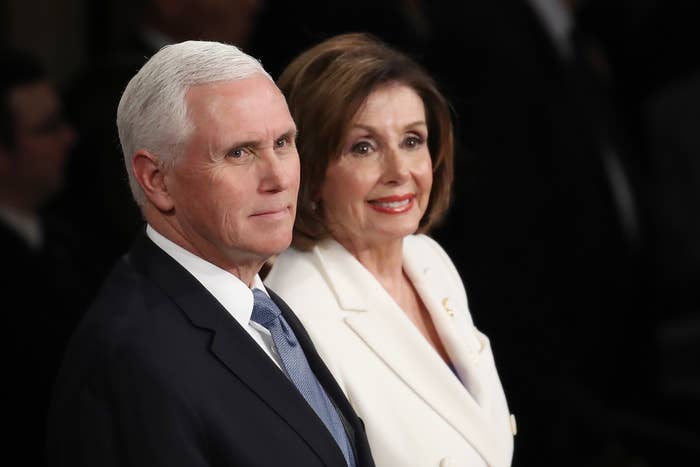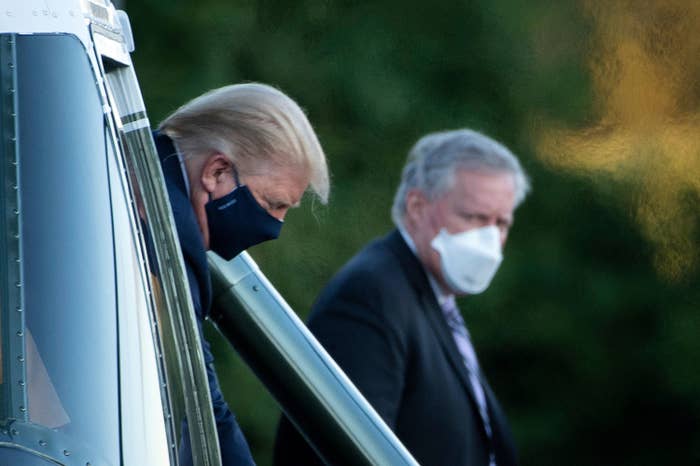
Since President Donald Trump announced he had the coronavirus, several of the leaders who would step in if he’s incapacitated, from Vice President Mike Pence to House Speaker Nancy Pelosi, have been releasing their own negative test results.
But negative results, especially in the first few days of being infected, are not as conclusive as they may seem. Medical experts caution that they can’t be taken as a definitive sign that people are not infected, and operating under a false assumption of a clean bill of health could put others at risk.
In this highly unprecedented and rapidly evolving situation, with Trump checking into Walter Reed Medical Center on Friday evening for an unspecified number of days, the health of each of the people in line to take over if necessary, and the safety measures they adopt, will be under close scrutiny. What happens next will depend on not just how the president’s condition progresses, but who around him stays healthy or gets infected and potentially infects others.
On Friday, Pence, Pelosi, Secretary of State Mike Pompeo, and Treasury Secretary Steve Mnuchin all said they had tested negative. Pence was the most recent of the group known to have seen Trump, at a coronavirus briefing in the White House Rose Garden on Monday evening. Pence had also seen Trump on Saturday and Sunday at other events, including the nomination of Judge Amy Coney Barrett to the Supreme Court.
For anyone who spends more than 15 minutes within 6 feet of an infected person, the CDC recommends quarantining for two weeks.
“There’s no single test that you can give someone and have absolute certainty they don’t have COVID,” Bill Morice, chair of laboratory medicine and pathology at the Mayo Clinic, told BuzzFeed News.
Under the 25th Amendment to the Constitution, Pence is next in the line of succession, followed by Pelosi and then Chuck Grassley, the Senate president pro tempore (a position generally given to the most senior senator in the majority party). Grassley had not come into contact with the president as recently as the others, but he did attend a hearing this week with Sen. Mike Lee, who tested positive Friday. Grassley, who has said he will not be tested, is followed by the secretary of state, Pompeo, and then the Treasury secretary, Mnuchin.
On Friday, the White House asserted that Pence was healthy. The vice president’s physician said in a statement that he “does not need to quarantine” and was “free to go about his normal activities,” and Pence said he will continue campaigning. He did not have any events scheduled on Friday, but on Thursday he attended a campaign event in Iowa where a crowd of about 600 people, few of them wearing masks, sat indoors at large tables, the Des Moines Register reported. Pence is due to debate Democratic vice presidential candidate Kamala Harris in person next Wednesday.

If the president was to become so ill as to need to step down either temporarily or permanently, the 25th Amendment provides four separate measures that outline what a transfer of power would look like.
The first two deal with what happens if Trump were to die or otherwise leave office — Pence would become president. Through the third part of the amendment, Trump could temporarily hand over power to Pence, who would serve as acting president. The fourth section, which has not previously been invoked, allows the vice president and cabinet to declare Trump “unable to discharge the powers and duties of his office.” That fourth measure has a high bar — it includes the ability for the president to force a congressional vote on whether or not he should be declared unable to perform his duties, with two-thirds majorities required in both houses.
Democratic presidential candidate Joe Biden was onstage with Trump, neither of them wearing masks, during the presidential debate three days ago. Biden announced that he and his wife had tested negative for COVID-19 on Friday morning, but rather than quarantining, continued with a planned visit to Grand Rapids, Michigan, on Friday afternoon. The former vice president has no other travel scheduled in the next few days, but his wife, Jill Biden, is traveling to several campaign events this weekend.
Others in Trump’s orbit who said they tested negative include Attorney General Bill Barr, Ivanka Trump, Jared Kushner, Barron Trump, and Trump’s Supreme Court nominee, Judge Amy Coney Barrett. (Barrett was diagnosed with COVID-19 earlier this summer and recovered.)
First lady Melania Trump and Hope Hicks, a top aide to the president, have both tested positive.
Whether leaders in the line of succession and other members of Trump’s administration got infected would depend on factors such as how much time they spent with someone who tested positive, whether they were indoors or outdoors, and whether they were masked and keeping a distance from one another. But whether a test would pick up on that infection depends on when they got infected.
A safe bet is to quarantine for at least 7 to 10 days to see if symptoms develop, which usually happens by then, experts say. If no symptoms emerge, and a test at that point still comes up negative, then their quarantining period could probably safely end.
What’s risky is if people get tested too early on, like within the first one or two days of an exposure, when the amount of virus in the body is too low to be detected. A person could get an inaccurate negative result and then, falsely believing they are healthy, possibly spread it to others.
“A negative test early after exposure tells you nothing about whether you’re infected or not,” said Ashish Jha, dean of the Brown University School of Public Health, in an interview Friday. “If somebody walks over right now and coughs in my face and I get the virus, it’s going to take a while for the virus to infect the tissues and replicate. A test today would be 100% negative. A test tomorrow would be close to 100% negative. A test on Sunday might be positive. But I would probably turn positive three to five days after exposure.”
He added that anyone who interacted with Trump, his wife, or Hicks over the past week should be quarantining.
And as Trump’s diagnosis shows, testing is not a bulletproof tool to keep the disease from spreading. To protect the president, the White House has relied predominantly on frequent testing while eschewing other measures known to reduce transmission, such as limiting crowds and wearing masks, much to the bewilderment of infectious disease experts.
“You can’t just pick one and do that and neglect the others,” said Saskia Popescu, an epidemiologist at the University of Arizona. “This is a really unfortunate example of that, one that nobody wants to see happen. If you told me that a random person was being tested daily and not following masking protocols or social distancing, and was in a lot of close-quarter meetings with dozens of other people, I would say it’s not surprising” that they got infected.
Correction: Nancy Pelosi is next in line for the presidency behind Mike Pence. The succession was misstated in a previous version of this story.

